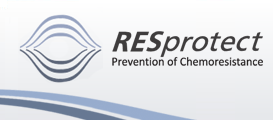| Inhibition of Induced Chemoresistance by Cotreatment with BVDU |

|

|

|
Page 10 of 12
Interestingly, in AH13r tumors or tumor cells, we could neither observe gene amplification or genome-wide changes (data not shown).
We used in situ CGH (18)
and PCR to test for amplification of genes that are frequently amplified in tumors, i.e. ß-actin (control), Erbb2, Gstt1, Mdr1, c-Myc, n-Myc, and topoisomerase IIa/GST- In additional in vivo studies, BVDU cotreatment enforced growth retardation of DMBA-induced fibrosarcomas and mammary adenocarcinomas in SD-rats. The DMBA-induced fibrosarcoma growth of control animals surpassed the fibrosarcoma growth of the DOX-treated rats only at the end of the treatment period. In contrast, DOX+BVDU-treated animals showed an inhibited tumor growth over the whole time period analyzed (Fig. 3B, panel 1). When the areas of individual tumors were compared 53 days after treatment, the mean tumor area of the DOX+BVDU group was significantly smaller than that of the DOX or control group (Fig. 4B, panel 2). We observed similar, but much more pronounced, effects with mammary adenocarcinomas (Fig. 4B, panel 1). DOX- (6 tumors) or DOX+BVDU-treated animals (9 tumors) showed an inhibited tumor growth over the whole treatment period in comparison with the control group (8 tumors). The areas of the individual tumors (Fig. 4B, panel 2) showed clear differences 39 days after treatment start. In 4 of 9 tumors of the DOX+BVDU group, a clear regression was observed. The overall tumor area of the DOX+BVDU group was significantly smaller than that of the DOX group or of controls. All of the differences were significant at the 5% level (t-test/Mann-Whitney test). Tumors of rats treated with DOX showed amplification and/or overexpression of the Mdr1 gene, whereas tumors of DOX+BVDU-treated or control rats showed neither amplification nor overexpression (Fig. 4B, panel 3).
|
||||||||||||||



 1 encoding gene (Top2a).
1 encoding gene (Top2a).